Barry Blanchard’s 10 Favourite Moderate Ice Climbs
A great list of classic routes to try to tick in one season

How does one decide on the top 10 fat ice moderates in the Rockies? For me, moderate is WI4+ at the most. Next, I wanted to get some geographic representation from where I’ve climbed and lastly I wanted the climbs with the best stories. Here we go.
Weeping Wall Left Hand WI4 180m in Banff National Park: My favourite WI4 climb in the range. Low hazard, a ten-minute approach and a sheet of blue ice the size of a football field. I’ve climbed and guided the route dozens of times because it is so sweet.
The first time I went there was to follow my good friend and ice guru, Kevin “Wally” Doyle up the route. February, 1980, Wally lead the crux with his usual panache. I teetered up tenuously talking to the Lord about every pick placement. “Please, God, let this hold.”
I had a 55 cm Serac Sabre in my left hand and a 25 cm Molinar Hammer in my right. Molinar was too short and I flailed to get him in. My knuckles took a bloody beating and my forearm wilted with exhaustion. God wasn’t listening, or he got bored with me. On the tenth swing Molinar bit, but I couldn’t hold onto him anymore. I plummeted yanking 15 feet of stretch out of the rope.
The 3 mm shoe string that I used for an umbilical cord to Molinar snapped. There I bobbed with the Serac Sabre in hand and Molinar, the bastard, still stuck in the ice three body lengths above me.
“Are you OK Blanch?” wailed Wally. “Ya, I’m alright! But I need some TENSION!” Getting back up to Molinar was THE hardest piece of climbing that I’d ever done. Monday I went and bought another Sabre. One year later Wally and I were back en route to the Upper Weeping Wall and its all been good on the Left Hand since then.

Takakkaw Falls WI4 250m in Yoho National Park: The greatest adventure in this selection, and the grandest waterfall. One month after our first climb of the Weeping Wall Left Hand I wheeled my MGB into Wally’s driveway. It was 11 pm on a Saturday night. Three hours later we started the 13-kilometre ski into Takakkaw Falls.
Night passed and the sun had been up for an hour when we were floundering through waist deep snow that had the consistency of granular sugar. Takakkaw is the Nakota word for majestic. I got it, the climb towered over us like a white on blue skyscraper.
Down and right of our first belay spray lifted from a massive open window in the ice, tons of water thundered below. The spray glazed onto the ice like candle wax in the frigid winter air, the hungry black hole roared. It was a scary place. I traversed over the hole collecting Wally precious new Chouinard screws and dropping them down the front of my anorak.
My body heat would melt the cantankerous ice out of their cores. While extending to full reach to hook one of Wally’s placements, my anorak pulled free from under my Whillans harness and I watched dumbfounded as five of the life protecting Chouinards bounded off down the ice and vanish into the black water. Half of our rack, “Bugger!”
We decided to continue. Postage stamp sized snowflakes began puking out of a sky that was the color of concrete. Mid day the first, and most massive, of three large spindrift avalanches roared over us. I screamed up to Wally when I saw it billowing onto us. We both thought that we’d be swept off, and were pleasantly surprised to find ourselves caked in snow but still ‘on’ after the slide passed.
We topped out in the storm, then rappelled to ski out in the dark. 24 hours after leaving it we were back at the MG … we both had to be back at work in Calgary in six hours.
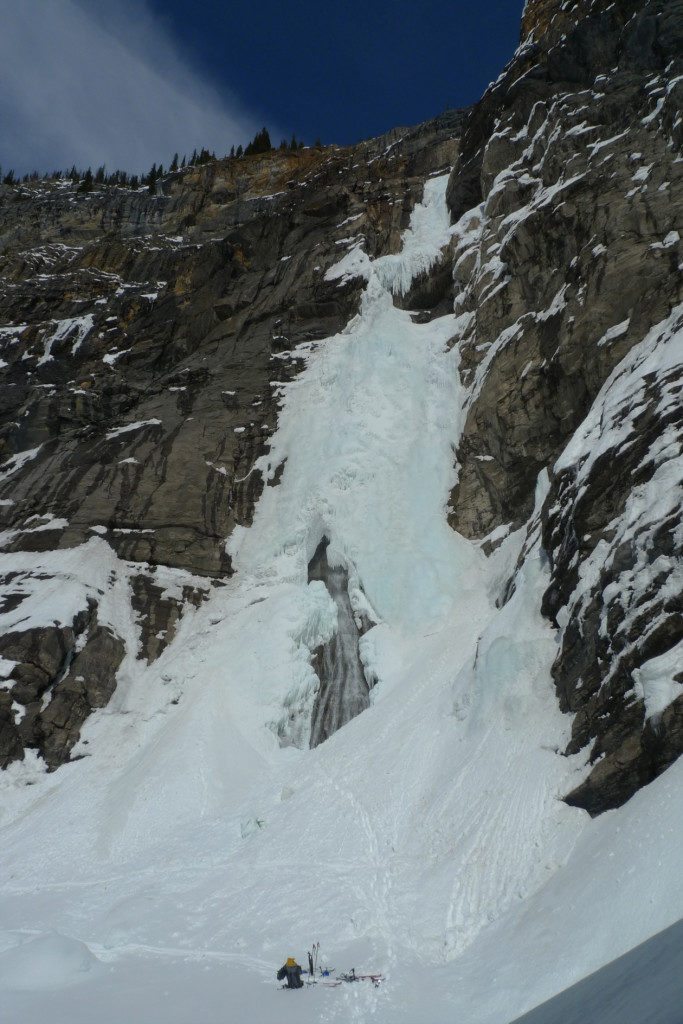
The Professor Falls WI4 280m in Banff National Park, Alberta: Most people don’t know that the route name is actually a short sentence. On the first ascent, Eckhard Grassman, a math professor at the University of Calgary, was trying to second the pitches clinging to bamboo shafted Chouinard Zeros, without wrist loops. Leashless before it was a term. The professor kept falling off.
By March, 1981, my ice climbing really started to click. I was beginning to understand it. Kevin Doyle, Bill Stark and Stewart Buroker, my usual partners, had all partied way too hard. I got up early, turned over the MG, and motored from Calgary to Banff by moonlight. Jerry Jeff Walker and Hank Williams provided the soundtrack. Banff was asleep. I drove all the way to the Kiosk at the start of the Banff to Canmore trail on the front side of Mount Rundle, something we use to be able to do. The route was a half hour walk away.
I started climbing just after dawn. Step after step of blue ice rolled by. I got locked into the rhythm of the climbing, concentrated without deviation for several hours. Even the fearsome top pitch, which use to be graded WI5, felt controlled, fluid. It was the first time that I, or any of my crew, had done a hard ice solo. I ran back to the MG, cranked Hank on the 8 track, and raced off to call Stewart.
“And you just couldn’t wait to tell one of us could you Blanch?”
“Hell no! I feel like a god!”
“Well congrats my deity. I’m jealous.”
Sweeter words were never said.
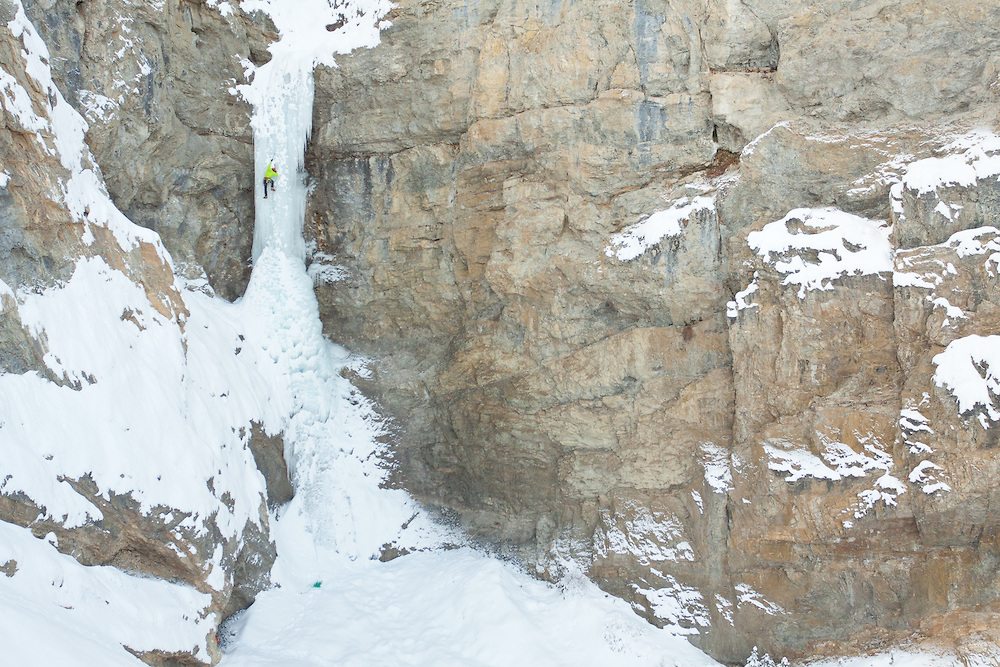
Moonlight WI4 110m and Snowline WI4 100m in Kananaskis Valley: These beauties form not five metres from each other. On a cold day in early January, 1982, Stewart Buroker and I thought that we were making a first ascent of what we later learned was Moonlight Falls. It was a skinny year and for the first half rope length the ice never grew thicker than grey.
I’d spent hours honing the picks of my Serac Sabres to a sharper, more aggressive point but they still plated off much of the ice and the teeth never sunk deep enough to bite. Every placement I locked off on was a wobbly and insecure hook. The shortest screws I had were eight inches. I’d try to get one in and the teeth would bite then twist in two revolutions before they hit rock. I could lever them by hand, so I’d rerack them and keep on going. Eighty feet up I had no option but to keep on going.
A hundred feet up I was truly and genuinely terrified. My arms were vibrating from effort and I could feel my hands opening on the tools. I knew that if I fell I would bleed out on the talus below, and I felt like I was going to fall. And then I got a solid stick and flopped around an edge to BLUE! Ice. I drilled home three 22 cm screws and stood there, panting, for 15 minutes.
One week later the Gal who was cutting my hair said “Do you know that you have a bald spot.” What! I was losing my hair! … at 23! I instinctively felt my crown, but she said “No, not there, ” and she guided my hand just above, and right, of the nape of my neck “here.” I felt skin as smooth, and bald, as a baby’s bottom. She held up a mirror, hairless pink scalp the size of two silver dollars.
“Oh god. Am I going bald?”
“No, not necessarily. It happens to men sometimes. Have you been really scared lately?”
“Oh yes. I scared the bejesus out of myself last week. Yes indeed.”
Stewart and I named the climb “The Glass Gamolin” in deference to time he’d spent in the Far East trying to find himself. We were later corrected by Al Dunham, one of the routes first ascentionists. We’d made the second ascent of Moonlight Falls, in very thin conditions.
But my skull was thick. Two weeks later Ian Stewart Patterson and I were back. We climbed the beautiful blue vein of Snowline. It was a first ascent, something that meant a lot to me then. Baby hair was sprouting on my bald spot.

Elliot Left-Hand Gully WI4 200m on David Thompson Highway: A route that I got to know for the first time, in the early 90s, as a Mountain Guide. One of the perks of the job, that -getting paid to go to beautiful new places. And the Kootenay Plains, that form the valley floor beneath the climb, are beautiful, and unique. An anomalously low snowfall area, I spent several peaceful hours that day gazing out on the braids of the North Saskatchewan River and the wind scoured emerald ice on the Abraham Reservoir. A huge heard of elk grazed the plains close to where I’d walked past sweat, and sun dance, lodges, built, and used ceremonially, by the Kiska Waptan Nakota people who live just to the east.
But it wasn’t all serenity, we’d climbed over a deep mound of avalanche debris that sat like the ruins of a bombed out cinderblock building. That hazard had subsided, but every time I glanced down to the debris I fretted on what was still up there over our heads.
The final pillar was a magnificent surprise. “How cool is that!” I blurted to my two ropemates when it came into view. Perfect climbing high on the flank of Mount Elliot with the mood of the valley embracing us. Back at the truck Nicole rolled the three of us cigarettes. I smoked mine slowly, offering the last of the tobacco to the valley.
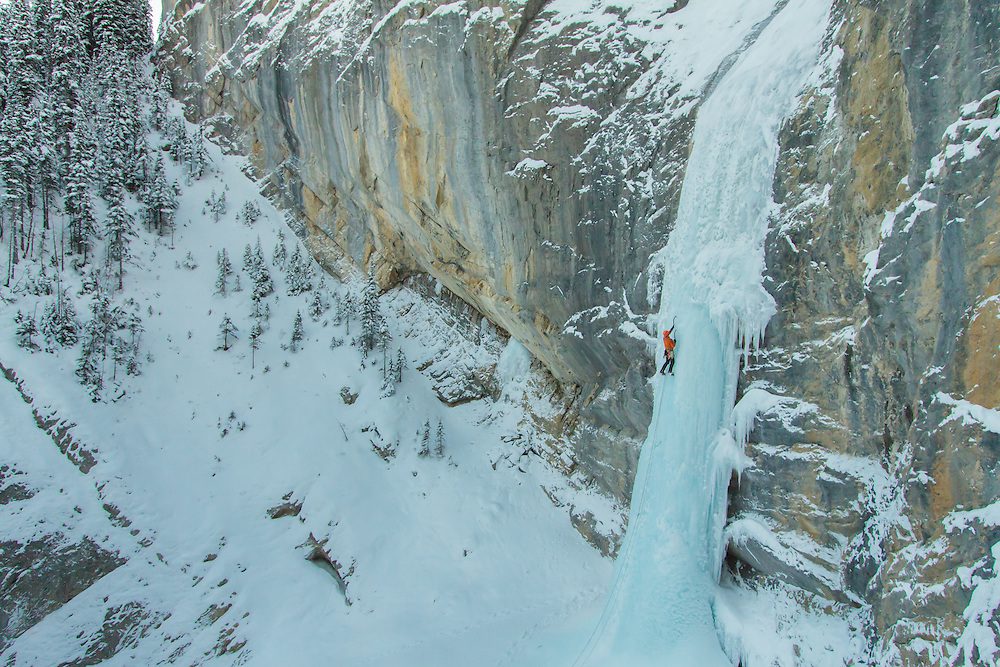
This House of Sky WI3/4+ 500m in Ghost River: Dec. 27, 1994, Alex Lowe was driving up from Bozeman, Montana, to climb with me in two days time. Kinda like having Wayne Gretzky show up at your house for the holidays wanting to join in on the neighborhood shinny hockey. I’d been sick as a dog for five days, hacking up jujube size hunks of green that looked like they had their own blood vessels, it felt like my frontal cortex was simmering in hot broth. Some Christmas.
“I can’t take this anymore.” I bleated to Catherine, my wife, the love of my life. “I HAVE to DO something tomorrow.”
“Yes, I think you should. You’re festering here. Rotting actually.”
I left early and I went alone. This House of Sky was perfect. Step after step of quiet blue solitude. At tree line the route opened up to a huge blue sky and I pondered on Ivan Doig’s phenomenal memoir of being raised by his father, and maternal grandmother -itinerant sheep farmers in Montana and Wyoming (Jo-Jo Josephson had named the route for it, and given me a copy of the book).
I took the route to the skyline that day -the summit ridge. To the north, I saw an incredible pillar linking to a long ice gully system. Two days later the Great One -Alex- and I made the first ascent of the Going To Sun Highway WI6 1,000m. We went all the way to the top of one of the sub peaks of Mount Costigan, nothing but sky above us. It was one of my best, and last, days in the mountains with Alex. He was killed in an avalanche on Sishipangma in 1999.
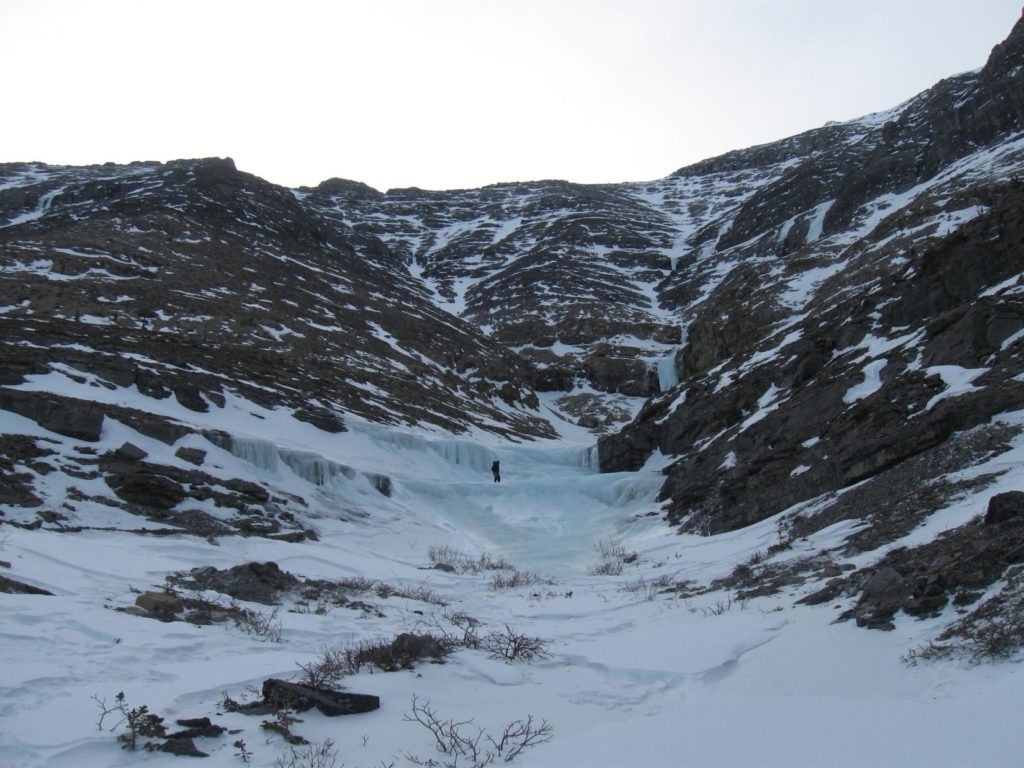
Lucifer WI4+ 100m along Castle River: In the mid 1990s my fellow Mountain Guide, Hans Peter Stettler, and I were comfortably ensconced, for a week, in the Kilmorey Lodge in Waterton Townsite. Hans Peter (HP) grew up a hotelier’s son in Grindelwald, Switzerland. The Eiger cast its shadow over HP’s upbringing. He gazed at its North Face on every clear day. That’s a top shelf mountain pedigree, HP can yodel with the best of them, and he knows his way around a good bottle of red wine.
We rented a snowmobile in Blaremore and the rental man was tickled to learn that we planned to putter up the Castle river hauling a sled. No highmarking, no leaving the snowpack with it. “Come back anytime you want.” He said.
The Sledding over, we punched uphill towards Lucifer, and its harder twin, Blue Angel (my intellectual ice mentor [his book, Climbing Ice, was my bible], Yvon Chouinard, had made the FA of that climb in 1977, the year I graduated High School).
The devil was kind to us that day. Anchored in a cave below the second pitch I bought up HP and marveled at how absolutely quiet it was. No human noise at all, at least until HP picked his way into view and ripped into a yodel, then shouted, “That pitch was SUPER! HA! HA! HA!” We were back to good food and fine wine late that night.

Bow Falls WI3/4 95m in Banff National Park: I’ve mostly adventured here practicing my profession as a Mountain Guide. Recently in the fine company of Jane, a Tasmanian born gal who lives in Australia and spends far too much time pushing her target heart rates. She had no problem keeping up to me on her very first time on showshoes (actually, I think that she got bored with the pace when I had trail to break!)
It’s a great day: Traverse Bow Lake, climb through some timber on the ski track that leads to Bow Hut while passing beneath the fine routes: Aimless Gully 100m III, WI4, and Pointless Gully 95m III, WI4 (those two make a fine enchainment, if you are into that kind of thing). Turn right off of the ski track into an amphitheatre vacated by Bow Glacier at the end of the Little Ice Age.
I like this trip because it is an adventure, yet relatively safe. You need snow shoes, or skis, to get there. There is little overhead threat and it is so high and north facing that it is often cold enough to be safe in hot spells when much of the other snow and ice is avalanching and falling down, further Bow Falls forms really early and stays really late.
But Jane and I had the threat of a wind slab on the approach slopes on March 1, 2008, and not only did she get to wear a avalanche beacon for the first time that day, she got to thread the needle through the wind slabs while having the rope anchored to screws in any, and all, available ice. Happy trails!
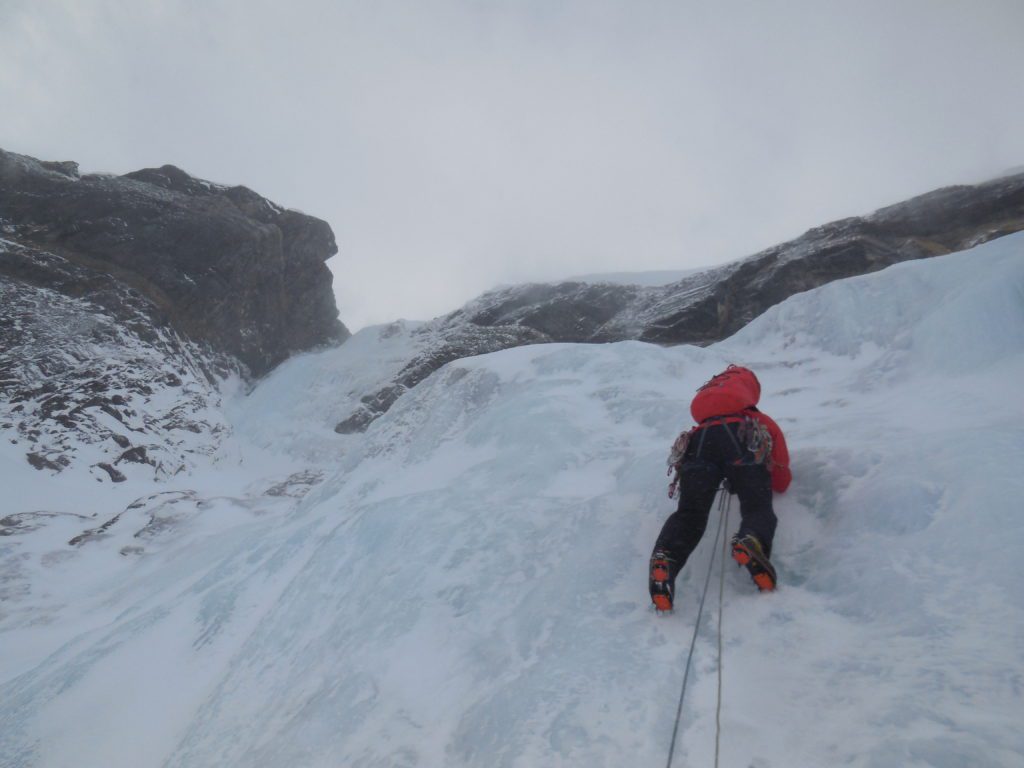
Pretty Nuts WI4 180m in Kicking Horse Canyon: Another climb that I got to know while guiding. Found myself driving from Canmore a lot in the later years of the last millennium and early years of this one. A long drive, but for what use to be the shortest approach in the Rockies … 5 minutes! But those days are gone as work on the Trans Canada Highway plunked ice climbers onto the radar and we now have to park several kilometres away and walk down the shoulder, or so I’m told -I haven’t been there since these changes have been made.
Similar to the Waterton phenomena, it can often be 10 degrees warmer on the far side of the continental divide, especially when an artic air mass has parked its butt over the eastern slope of the Rockies. Into the late 90s that would give us our traditional, Albertan, -40s; we just don’t see that anymore (just ask the mountain pine beetle); still, -30 can make ice climbing unpleasant so it is nice to have some warmer climes in your back pocket.
And Pretty Nuts is a winner. Take Jo-Jo’s guidebook advice and traverse east for 50m after the obvious first big fat flow and second step. The surprise final pitch that you find in the forest is like the icing on a gingerbread house, delicious, and TOO MUCH FUN!

This article by top ice climber Barry Blanchard first appeared in the winter edition of Gripped magazine in 2010


